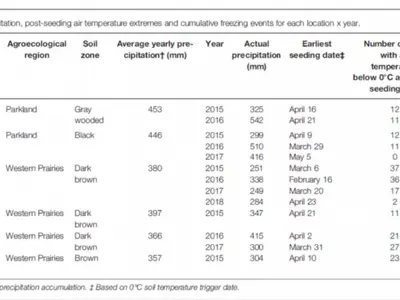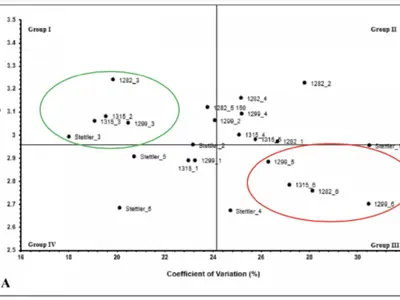Ultra-Early Seeding - How Early is Too Early?
In an article dated April 17, 2020, Graham Collier, a PhD Student with the University of Alberta discusses early seeding, how early is too early, and what the research suggests for success when it comes to seeding wheat.
'You’ve probably sat in an agronomy meeting and heard that early seeding is a good thing; you can capture more spring moisture, get the crop out of the ground and ahead of weeds, get early crop canopy closure and more. But how early is too early? Many research papers have established that the early seeding timing(s) in their agronomic study performed better than the later timing(s), especially with cereals, but few have tried to answer the question: just how early can we seed wheat? Recent research completed in Western Canada by Agriculture and Agri-Food Canada and the University of Alberta aimed to find this answer.
One of the first considerations is defining what “early” means. May 1 might be early one year, but April 1 might be early the next. April 30 might be just right near Vegreville, and March 30 might be more realistic near Enchant. Using the calendar date to predict seeding time doesn’t work well from area to area, or from year to year. Instead, our study used soil temperature as the trigger to begin seeding.

This table shows the locations and years the studies were conducted. The earliest seeding date was triggered by the first day where the soil temperature at 5cm (2”) depth reached 0°C at 10:00 am. Each consecutive seeding date was then triggered by a 2°C increase in soil temperature (measured at the same depth and time of day).There was a wide variation in the first seeding operation from location to location and from year to year. For example, the earliest operation related to the first seeding date trigger of 0°Cin Lethbridge was February 16 in 2016; however, in 2017,Lethbridge was not able to start seeding at the same soil temperature until a full month later, March 20. By using soil temperature as a trigger, we can better standardize seeding time from year to year compared to using an arbitrary calendar date.
The first study evaluated six seeding dates based on two-degree incremental increases in soil temperature from 0°C to10°C. A commercial Canada Western Red Spring (CWRS) wheat variety, AC Stettler, was compared to three cold tolerant wheat lines (LQ1282A, LQ1299A, and LQ1315A). The cold tolerant lines were originally derived from a cross between a winter and a spring wheat cultivar and then selected for growth habit, agronomic performance, and cold tolerance. Cold tolerance was determined using LT50 tests, or lethal temperature tests, which evaluate cold tolerance by identifying the temperature at which 50 per cent mortality occurs among seedling plants. In the LT50 tests the spring growth-habit, cold tolerant lines exhibited cold tolerance equal to or greater than some commercial winter wheats. The main indicators we used to determine the success of an ultra-early seeding system were system stability and grain yield. Grain yield is self-explanatory, but system stability is a bit more complex. System stability is a measure of how consistent the yield of a treatment is across environments. It is determined by plotting treatment combinations based on their indicator variable, in this case grain yield, and their coefficient of variation. The more inconsistent the yield results of a treatment (seeding date x variety), the greater the coefficient of variation. Thus, our best treatments have the lowest coefficient of variation and the highest grain yield.
For analysis, the study sites were split into two groups: sites north of 51°N latitude (Edmonton, AB, Scott, SK, and Dawson Creek, BC) and sites south of 51°N latitude (Lethbridge, AB, Regina, SK, Swift Current, SK). The sites north of 51°N latitude showed no significant difference in grain yield between treatments, and exhibited mixed system stability responses; in other words, there was no penalty to grain yield or system stability for seeding ultra-early.

Figure 1: Biplots summarizing yield means vs. coefficient of variation for sites south of 51°N latitude. Abbreviations are as follows: I) First number/name represents the wheat line (AC Stettler, LQ1282A, LQ1299A, LQ1315A). II) Second number represents planting date 1 (earliest) – 6 (latest). Grouping categories: group I: high mean, low variability; group II: high mean, high variability; group III) low mean, high variability; group IV) low mean, low variability.
(From Collier et al. 2020)
Figure 1 shows system stability and yield responses for sites south of 51°N latitude. The highest yielding and least variable treatments (green circle) were those planted at dates 2 and 3, corresponding to soil temperature triggers of 2°C and 4°C. The lowest yield and most highly variable treatments (red circle) tended to be those that were seeded at dates 5 and 6, orresponding to 8°C and 10°C soil temperature triggers. You may notice that AC Stettler yielded less than the cold tolerant lines – this is not due to a poor response to cold soil temperatures. AC Stettler showed excellent cold tolerance, as good as the cold tolerant varieties (most AC Stettler points are left of the vertical dividing line in figure 1). The lower yield of AC Stettler relative to the cold tolerant lines is a result of it being a CWRS variety and having a higher grain protein content than the cold tolerant lines, which would be more appropriately classified as Canadian western special purpose lines, with high yield potential but lower grain protein content (Table 2).
At sites south of 51°N latitude, seeding between soil temperatures of 2°C and 4°C provided the greatest grain yield (Table 2). Seeding ultra-early into 0°C soils did not result in lower grain yield than waiting and seeding into soils at 6°C to 8°C, and actually resulted in greater grain yield than waiting for soils to reach 10°C prior to seeding. Ultra-early seeding did not significantly affect grain protein content, test weight, or thousand kernel weight of grain. Nor did it affect plant height or the number of heads per plant.
Heads per square meter were lower at later seeding times indicating that ultra-early seeding times had good survivability despite the extreme weather conditions captured in Table 1.
The recommendations from this study are for growers to begin shifting wheat to earlier seeding. Seeding into soils as cold as 0°C was not detrimental to grain yield or system stability compared to waiting for soils to warm beyond 6°C. Optimum yield and system stability were achieved when seeding occurred at 2°C and 4°C soil temperatures. Based on the lines we assessed, we would conclude thus far that specialized cold tolerant varieties are not required to successfully seed ultra-early; however, there may be opportunity in the future to tailor wheat genetics to an ultra-early system. Important agronomic recommendations to support successful ultra-early seeding include the use of a dual fungicidal/insecticidal seed treatment (read our recent article Seed treatment impacts early season abiotic resistance) to protect seed sitting for longer periods in cooler soil and to increase seedling vigour (as emergence will take longer from cooler soils). Seeding rate is an important part of a successful ultra-early seeding system, and a seeding rate providing 400 viable seeds per square meter (approx. 40 seeds per square foot) is recommended.
Additional research is underway to evaluate seeding depth, the full benefits of higher seeding rates, combining ultra-early seeding with soil-applied residual herbicides to manage weeds in the absence of a burndown herbicide application, fertility programs for ultra-early seeding, and evaluating multiple wheat varieties from multiple classes for suitability in an ultra-early seeding system.'
Contact Us
Saddle Hills
Junction of Hwy 49 & Secondary Hwy 725
RR1, Spirit River AB
T0H 3G0
T. 780-864-3760
Fax 780-864-3904
Toll-free 1-888-864-3760
frontdesk@saddlehills.ab.ca
Sign up to our Newsletter
Stay up to date on the Saddle Hills activities, events, programs and operations by subscribing to our eNewsletters.

